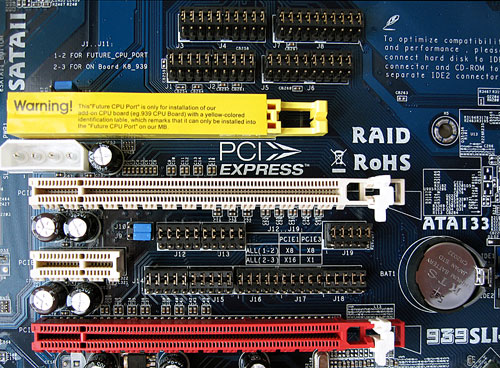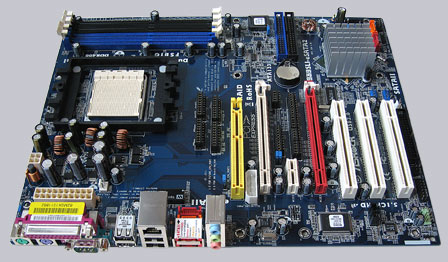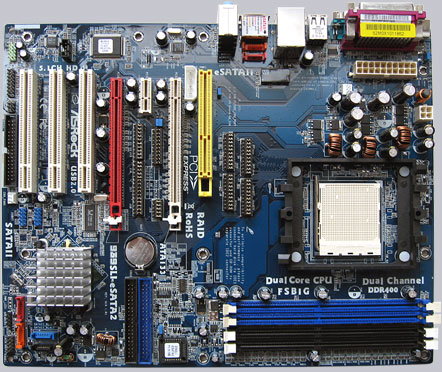
Result and general impression
+++ The ASRock 939SLI-eSATA2 motherboard has a price of approx. 60 Euro (06/2006) and is once again less expensive than previously tested PCI-E SLI motherboards.
After the previous reviewed ASRock 939SLI32-eSATA2 Motherboard I’ve decided to test this 939SLI-eSATA2 motherboard as well, and anyone who like to save 10 Euro compared to the SLI32 pendant shouldn’t miss this Review.
As already mentioned in the recent PCI-E SLI (2 PCI-E graphics card slots) reviews, most of the SLI motherboards offer just 2 PCI slots, due to the standardized ATX form factor.
ASRock managed with this 939SLI-eSATA2 to place all the 3 PCI slots, in addition to the two PCI-E 16x slots for the video cards. But this board offers “only” two 8x PCI-E slots for the graphics cards, where it’s possible to increase the data rate with a few jumpers to 16x if only one PCI-E slot is used. Anyway, depending on the video cards used and the application, the performance difference of the PCI-E 8x compared to the PCI-E 16x is nearly impossible to measure, so there’s currently no reason to worry about two PCI-E 8x slots.
In addition this motherboard has a PCI-E 1x slot, a power connector for graphics cards, and a slot for the optional AMD AM2 CPU (940-pin) riser card. The keep-out space (about 40 mm) around the CPU socket area on the 939SLI-eSATA2 leaves enough room for large CPU coolers.
On this picture you see the ASRock AM2 CPU slot with the protection lable and the two PCI-E slots, where the white PCI-E slot is the PCI-E 16x slot on single operation:

Furthermore the board can be equipped with a total of 4 memory modules and is thus upgradeable up to 4 GB memory. The allocation for the DUAL Channel memory assembly is mentioned in the user manual and should be followed exactly.
Moreover, the board offers 2x IDE connectors for up to 4x ATA 133 hard drives, 4x SATA-II ports (RAID 0/1) and 2x eSATA-II ports for external hard drives, which have to be installed at two of the four internal SATA-II ports. Included with delivery is a bootable CDROM and a short guidance for the correct installation of the Serial ATA-II ports. The manual also includes all of the information you need to manage a new Microsoft Windows XP installation with a primary S-ATA HDD.
In addition there are 4x USB 2.0 ports at the ATX panel, 2 internal USB 2.0 plugs for 4 optional USB ports and an onboard 10/100 LAN with WoL (Wake on Lan). The onboard RealTek ALC-660 sound chip offers 5.1 surround sound over 3x 3.5mm connectors, but there aren’t any digital outputs.
Let us now start with the BIOS options. By pressing the “F2” key, you get access to the AMI BIOS. In the BIOS menu are e.g. options to change the memory frequency from 133 MHz over 166 MHz up to 200 MHz (divider 3:2/4:3/1:1). The host clock is adjustable from 90 MHz up to 340 MHz and the HT (hypertransport) frequency from 1x to 5x (200/400/600/800/1000 MHz) beside extensive memory timings. The optional synchronous or asynchronous setting of the CPU/PCI-E Bus with a fix PCI clock of 33.33 MHz up to 37.5 MHz is a very helpful feature for good overclocking results.
The largest noticeable difference to the ASRock 939SLI32-eSATA2 pendant is the clearly lower overclocking result, which was achieved in the test. Because of the very high SLI32 motherboard overclocking result of approx. 300 MHz reference clock this board reached “only” a maximum frequency of 255 MHz. By increasing the chipset voltage this result could be surely improved, but it’s difficult to get higher results than approx. 270 MHz with this ULi based chipset (also with tuning BIOS).
The BIOS setup offers memory voltage (VCCM) and the CPU voltage (VCore) settings and it’s possible to rise the CPU voltage a bit more with the new socket 939 pinmod guide.
Most monitoring values like the CPU temperature, chipset temperature and fan rotation speeds are shown in the BIOS, but it would be nice to also have all voltages and the useful “CPU Overheat Shutdown” option. According to the manual the CPU is protected against too-high temperatures, but in the current BIOS version aren’t any settings to adjust this shutdown temperature.
Result: The ASRock 939SLI-eSATA2 Socket 939 PCIe SLI Motherboard offers great equipment, a lot of upgrade options and a very good performance! The maximum overclocking of the chipset is clearly below the 939SLI32-eSATA2 Motherboard, but in view of the extremely favourable price the ASRock 939SLI-eSATA2 Motherboard is likewise very recommendable. However, those who like to reach the highest overclocking result should invest those extra 10 Euro for the 939SLI32-eSATA2 which includes a 1 Gigabit LAN onBoard chip.
All in all, the ASRock 939SLI-eSATA2 is an awesome Motherboard for all bargain hunters and thanks to the very low 939 CPU prices it’s surely a good alternative to the newer Socket AM2.
Special thanks to ASRock for their support.
**** All Socket 939 motherboard reviews since 01.11.2005 are based on an AMD Athlon 64 3000+ Venice processor, 1x (or SLI systems with 2x) Gigabyte GV-NX66T128VP nVidia 6600 GT PCI Express video cards and the following software configuration: Microsoft Windows XP SP2, DirectX 9.0c, Forceware 81.85 video driver and 3DMark 2003. All benchmark results should only offer a comparison among themselves for a comparison.



